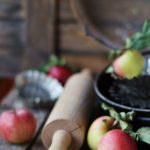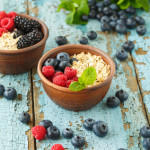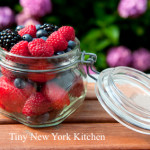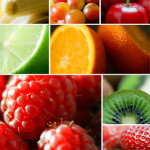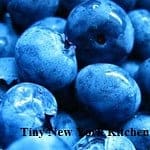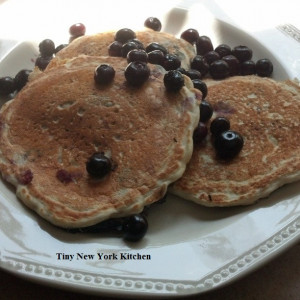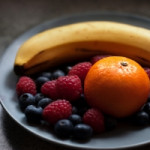Autumn’s bounty is vibrant, varied, and delicious. Apples of all varieties are now available at farmers’ markets and supermarkets, including crunchy, sweet Honeycrisp, gorgeous Galas, MacIntosh mottled with both green and red, pale yellow Ginger Golds, and dark, dusky Paula Reds.
Apples are the perfect snack, satisfying and sweet. Try slicing an apple, place the slices in a plastic baggie, sprinkle liberally with cinnamon, close the bag, and shake until the slices are well coated with cinnamon. The apple slices will stay crisp and white for several days in the refrigerator. Perfect for grab and go school lunches, picnics or work from home snack breaks.
A versatile cooking ingredient, apples go well with both sweet and savory components. Combing apples with plums, cranberries, figs, raspberries or blueberries will yield particularly pleasing desserts, such as pies, puddings, tarts, cobblers, and crisps. Whether baked, poached or sautéed, apples lend marvelous layers of flavor to breads, sauces, slaws, salads, stuffing, coleslaw, chutney, and relishes.
As the weather turns cooler, what could be more comforting than the scent of apples roasting in the oven, mingling with spicy cinnamon. Apples enjoy an easy association with all manner of spices, including allspice, cloves, ginger, and nutmeg.
©Tiny New York Kitchen © 2020 All Rights Reserved
These freezer essentials will help you with your weekly meal prep as well as last minute meals that you need to get on the table fast.
Bagged frozen vegetables, like mixed peppers, broccoli, and spinach.
Bagged frozen fruit, like blueberries, mangos, bananas, and strawberries.
Bagged frozen pastas, like tortellini and ravioli.
Frozen waffles and pancakes.
Frozen potatoes, like tots, fries, and breakfast potatoes.
Rice and prepared side dishes.
Pre-made dough, pie crusts, and breads.
Frozen foods are not limited to frozen dinners. You can stock your freezer with healthier ingredients to make putting dinner together easy. There are endless possibilities with what you can make with frozen ingredients. As always, be creative and “work with what you got!”
“Work With What You Got!”
©Tiny New York Kitchen © 2020 All Rights Reserved
You may substitute any berries for this delicious mug cake.
“Work With What You Got!”
©Tiny New York Kitchen © 2019 All Rights Reserved
Here is another use for the whole grains and seeds that you’re seeing at the store. Top off with delicious flavoring, which are also tasty on oatmeal.
Amaranth (3/4 Cup)
Bring 2 1/4 cups water or milk to boil in saucepan. Stir in amaranth. Reduce heat to low, cover and simmer until tender. Cooking time is 25 to 30 minutes. Stir occasionally. Remove from heat and mix in or top with dried cherries, coconut sugar, macadamia nuts, vanilla, banana, or cacao nibs. Serves 2
Millet (3/4 Cup)
Bring 1 1/2 cups water or milk to boil in saucepan. Stir in millet. Reduce heat to low, cover and simmer until tender. Cooking time is 15 to 20 minutes. Stir occasionally. Remove from heat and mix in or top with chopped dates, demerara sugar, hazelnuts, cloves, clementine, or granola. Serves 2
Quinoa (3/4 Cup)
Bring 1 1/2 cups water or milk to boil in saucepan. Stir in quinoa. Reduce heat to low, cover and simmer until tender. Cooking time is 15 to 20 minutes. Stir occasionally. Remove from heat and mix in or top with dried apricots, agave syrup, pine nuts, cardamom, blueberries, or toasted coconut.
Serves 2
“Work With What You Got!”
©Tiny New York Kitchen © 2018 All Rights Reserved
Care & Handling Of Berries
Strawberries: Pick strawberries at their peak of ripeness. Look for symmetrically shaped berries; a brilliant sheen and rich even red color; fresh unwilted green caps; avoid strawberries with seedy tips or white shoulders. A white “core” in your strawberries is not an indication of ripeness. The internal pigment of strawberries ranges from white to bright red and is a characteristic of the berry plant variety and not of the berries’ ripeness or flavor.
Raspberries: When choosing raspberries look for plump, evenly colored berries that have a soft and hazy gloss and are free of dents and bruises. Raspberries have tiny hairs on them called “styles.” These are a completely natural part of the fruit’s defense mechanism and do not affect the taste or ripeness of the berries.
Blueberries: Choose blueberries that are dry, plump, round and free of dents and bruises. Blueberries should have a soft , hazy white coating, which is called “bloom.” Bloom is a completely natural part of the berries’ defense mechanism and helps protect them from the harsh rays of the sun. Avoid blueberries that are shriveled or lack bloom.
Blackberries: Look for deep, evenly colored blackberries with a nice sheen. Berries that are plump and dry and free of dents or bruises. Blackberries range in color from deep blue/purple to deep purple/black. Blackberries are often two-tone in color, which is perfectly natural and does not affect ripeness.
All fresh berries are highly perishable and should be refrigerated at all times until eaten or used as an ingredient. Refrigeration will extend freshness and shelf life.
It is recommended that you wash all berries before using them. However, you should never wash your berries until just before you are ready to eat or use them, as the moisture will decrease their shelf life.
Fresh berries can be easily frozen and enjoyed until you are ready to use them.
Wash strawberries carefully in cold water and pat dry. Remove the stems and any soft spots. Pack the berries into freezable containers or freeze them on a baking sheet and then pack them into containers as soon as they are frozen. Seal containers and keep frozen until you are ready to use them.
Raspberries and blackberries are very fragile and fresh raspberries are very sensitive to freeze damage. To freeze raspberries and blackberries rinse them gently in cool water then allow them to dry in a colander or on paper towels. Place a sheet of wax paper on a baking sheet then place berries in freezer. After berries are frozen, pack them into sealed containers until you are ready to use them. By freezing the berries this way, they won’t stick to each other which allows you to easily measure out the needed amount once you are ready to use them.
If you plan to freeze your blueberries, do not wash them before freezing as doing so will make the blueberry skins tough. Instead pack your blueberries into freezable containers, or freeze them on a baking sheet and then pack the into containers as soon as they are frozen. Seal the container and keep frozen until you are ready to use them. Be sure to wash the thawed blueberries prior to use.
Berries are delicious, nutritious, disease-fighting fruits. With their high antioxidant levels, berries are also considered “superfoods” because their health benefits may help the body fight off disease and slow the effect of aging. Berries are also high in vitamins and low in calories so they are a perfect fruit to include in your daily diet.
Antioxidants are natural substances found in plants, which are known, to aide in the prevention of heart disease, cancer and strokes. They provide protection by neutralizing free radicals, which are substances that form when oxygen is burned by the body. Free radicals travel through cells, disrupting the structure of other molecules, causing cellular damage. This cell damage is believed to contribute to aging and various health problems. In addition to boosting your immune system, antioxidants have been found to slow the effects of aging by improving memory, balance, coordination and motor skills. Berries are some o the most delicious and powerful disease-fighting foods available. Considered “superfoods,” antioxidant levels in berries are measured by their ORAC (Oxygen Radical Absorbance Capacity) Value.
“Work With What You Got!”
© Victoria Hart Glavin Tiny New York Kitchen © 2016 All Rights Reserved
Have you ever come home from the market after purchasing fruit to find that you spent money for nothing? I have plenty of times and it ticks me off every time. Here are some Fruit Essentials that may help you have more fruit shopping success.
Did you know that many plants that are botanically fruits are not sweet? We think of them as vegetables or non-fruits. Avocados, beans, coconuts, corn, cucumbers, eggplants, green peppers, okra, peas, pumpkins, sugar peas, string beans and tomatoes all fall in the fruit category. Some cookbooks make a distinction between fruit, vegetables and fruit vegetables. Fruit vegetables are foods that are botanically fruits, but are most often prepared and served like vegetables. These fruits are considered fruit vegetables: Aubergine, autumn squash, avocado, bitter melon, cantaloupe, chayote, chile, courgette, cucumber, eggplant, gherkin, green bean, green sweet pepper, hot pepper, marrow, muskmelon, okra, olive, pumpkin, red sweet pepper, seedless cucumber, squash, sweet pepper, tomatillo, tomato, watermelon, wax gourd, yellow sweet pepper and zucchini.
Pectin is a substance contained in some fruit which is used for making jams and jellies thicker. High pectin fruits are apples, cranberries, currants, lemons, oranges, plums and quinces. Low pectin fruits are bananas, cherries, grapes, mangos, peaches, pineapples and strawberries.
Low pectin fruits seem to discolor quicker than high pectin fruits ( bananas and eggplants). Lemon juice or vinegar slows the discoloring process. Other fruits and vegetables that discolor quickly are avocados, cauliflower, celery, cherries, figs, Jerusalem artichokes, mushrooms, nectarines, parsnips, peaches, pears, potatoes, rutabaga and yams.
Bruising: When a fruit is bruised the cell walls break down and discoloration begins. The process can be slowed down by refrigeration.
Cleaning: It is important to clean our fruit and vegetables. Rinse fruit in cold running water and scrub as needed before cooking or eating. Soaking fruit in water for more than a few minutes can leach out water soluble vitamins.
Peeling: The fruit skin usually contains a lot of important nutrients, but if you need to peel a thick-skinned fruit cut a small amount of the peel from the top and bottom. Then on a cutting board cut off the peel in strips from top to bottom. A good way to peel thin skinned fruit is to place the fruit in a bowl with boiling water and let stand for about 1 minute. Remove and cool in an ice water bath. You could also spear the fruit with a fork and hold over a gas flame until the skin cracks OR quarter the fruit and peel with a sharp paring knife or potato peeler.
Wax: Oh those beautiful waxed apples that wink at us at the market. They are beautiful because they are waxed. I don’t know about you, but I would rather not eat wax. Wax can be removed from the surface of fruits by washing them with a mild dishwashing soap and then thoroughly rinsing them. This will remove most of the wax, but probably not all of it.
Purchasing Ripe: Purchase these fruits fully ripe: Berries, cherries, citrus, grapes and watermelon. All of the fruits in this list, except berries, can be refrigerated without losing flavor.
Purchasing Not-So-Ripe: Apricots, figs, melons, nectarines, peaches and plums develop more complex flavors after picking. Store these fruits at room temperature until they are as ripe as you would like them.
Refrigeration: You can refrigerate apples,ripe mangos and ripe pears as soon as you get them. Do not refrigerat bananas.
Seasonal Fruit: Winter is the season for citrus. Fall is the season for apples and pears. Late spring is the season for strawberries and pineapples. Summer is perfect for blueberries, melons, peaches and plums.
Washing: Dry fruit with paper towels or kitchen towels and then use a blow dryer on the cool setting to completely dry fruit.
Squeezing: A microwave can be used to get more juice from citrus fruits. Microwave citrus fruits for about 20 seconds before squeezing the fruit for juice.
Select blueberries that are plump and juicy. You will want to make sure that they have NO trace of mold or discoloration. Look for firm and uniformly sized blueberries that are deep in color.
Store your blueberries in the refrigerator in a moisture-proof container for up to 3 days. If you will be eating your blueberries within 24 hours of picking then store them at room temperature. If you would like to use them at a later date then just pop them in the freezer. Make sure NOT to wash them before freezing.
Prepare your berries by washing just before using them.
Uses for blueberries are virtually endless. They can be eaten out of hand, in pies, pancakes, salads, salsa, jams, jellies and cakes. Be creative and create your own blueberry dishes!

